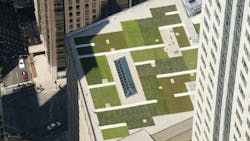7 Passive Cooling Strategies for Energy-Efficient Buildings
Managing a building is a constant opportunity, primarily for energy-efficient improvements like passive cooling. These strategies involve numerous technologies and behavioral changes to decarbonize a home or facility, ranging in complexity and price. Discover which delivers results and how multiple solutions could be the answer to a sustainable structure.
Green and Reflective Roofs
Retrofitting an existing roof to incorporate green elements is possible with some foresight and auditing. The plant life absorbs heat and water, allowing temperatures inside to be less volatile. The supports and insulation in attics and roofs must be able to withstand the weight of water, soil, and plants without leaking or caving in.
If executed correctly, a green roof boosts the insulation potential of a building. Additionally, the passive cooling effects impact other structures nearby. It lowers the average temperature of urban heat islands, making them a practical yet aesthetic upgrade for any electricity-aware project.
The parts of it without vegetation can use reflective or cool roof techniques. These include applying paints and coatings to push light and heat away from the building. Architects and engineers have tested what shades are best for this, with white being the victor. The color should reflect 30%-60% of sunlight to improve cooling.
Rooftop solar panels are also reflective and cooling because they repurpose the power that would warm the facility and use it as electricity. Managers can store excess generation and turn it into thermal power, which accounts for 50% of energy applications in most structures.
Thermal Mass Utilization
Building managers can capitalize on thermal mass utilization by picking the right materials, primarily for structural facets more exposed to the elements. The idea is a pillar of passive solar designs, which use awnings, building orientation, and Trombe walls to control indoor environments.
Concrete, brick, and wood are examples of components that store heat well during the day and gradually release it at night. This functionality stabilizes indoor temperatures, giving a cooling effect by mitigating the sun’s intensity.
Leveraging materials with these qualities eliminates excessive mechanical cooling demands. The reduction lowers the structure’s carbon footprint further by using fewer resources and electricity.
Natural Ventilation
Many refuse to open windows to let balmy air in, but they can provide passive cooling if natural ventilation is positioned strategically. Windows, vents, and other openings in shaded places can let gentle breezes in while improving indoor air quality.
Building operators can determine the best locations for them by using computational fluid dynamics modeling. These simulations find the best opportunities for maximum airflow to get the fresh air into as many areas as possible without compromising its cooling impact.
Shade Structures and Overhangs
Shades and overhangs prevent direct sunlight from disrupting internal conditions when at its peak. The warm rays enter when the sun is going down—when temperatures are lowering for the day. Solar heat gain is easier to manage, and cooling loads are less burdensome on electronic and mechanical systems.
Architects and managers should use building information modeling programs to sense how positioning and the geography’s weather tendencies would influence an awning’s location. Incorporating flexibility into the design allows for passive cooling adaptability all year.
Landscaping for Cooling
Facilities can use the surrounding property to add shade and absorb more warmth. Trees, shrubs, and other vegetation are ideal instead of artificial turf. While the latter is lower maintenance, the perpetually short synthetic grass causes the area to get hotter faster.
Manufacturers and urban small businesses alike can draft landscaping plans to include native wildlife. Other strategies involve planting deciduous trees on buildings’ south sides to tackle summer sunlight.
Earth-Air Heat Exchangers
These are underground tubes that take the warmth radiating from the earth and cool it before it impacts a building. It is a strategy for facilities and households looking for a comprehensive cooling system because it examines radiant energy from all angles. The soil around the tubes naturally cools the air as it travels through the pipes.
If facilities are attempting to lower humidity to cool temperatures, some types of systems eject heat at 123 degrees F. but only contain 10% relative humidity. The areas feel cool because the earth-air exchanges mitigate geothermal heat, and the humidifier can work while cutting moisture.
Solar Chimneys
Construction professionals building townhomes or industrial complexes needing retrofits for office segments can leverage solar chimneys for passive cooling. The inside is painted and absorbs any entering warmth. Many solar chimneys also incorporate phase-change materials that shift their state to accommodate more heat-absorption or release needs.
Because heat rises, the tunnel forces the warm air back out, acting like a suction for the connected rooms. This movement allows the cooling strategies closer to the ground to be more effective. The chimney’s inlet placings are crucial for harnessing the most power while encouraging effective airflow.
Passive Cooling Everywhere
Most structures have one point of control when it comes to internal temperatures—a thermostat. The overreliance on this single technology reveals how many opportunities buildings have to become more efficient by knowing how and where to move cooler air. They severely impact the climate crisis, so implementing one or more of these methods can have significant, long-lasting gains for positive climate action.
About the Author
Ellie Gabel
Ellie Gabel is an associate editor for Revolutionized.
